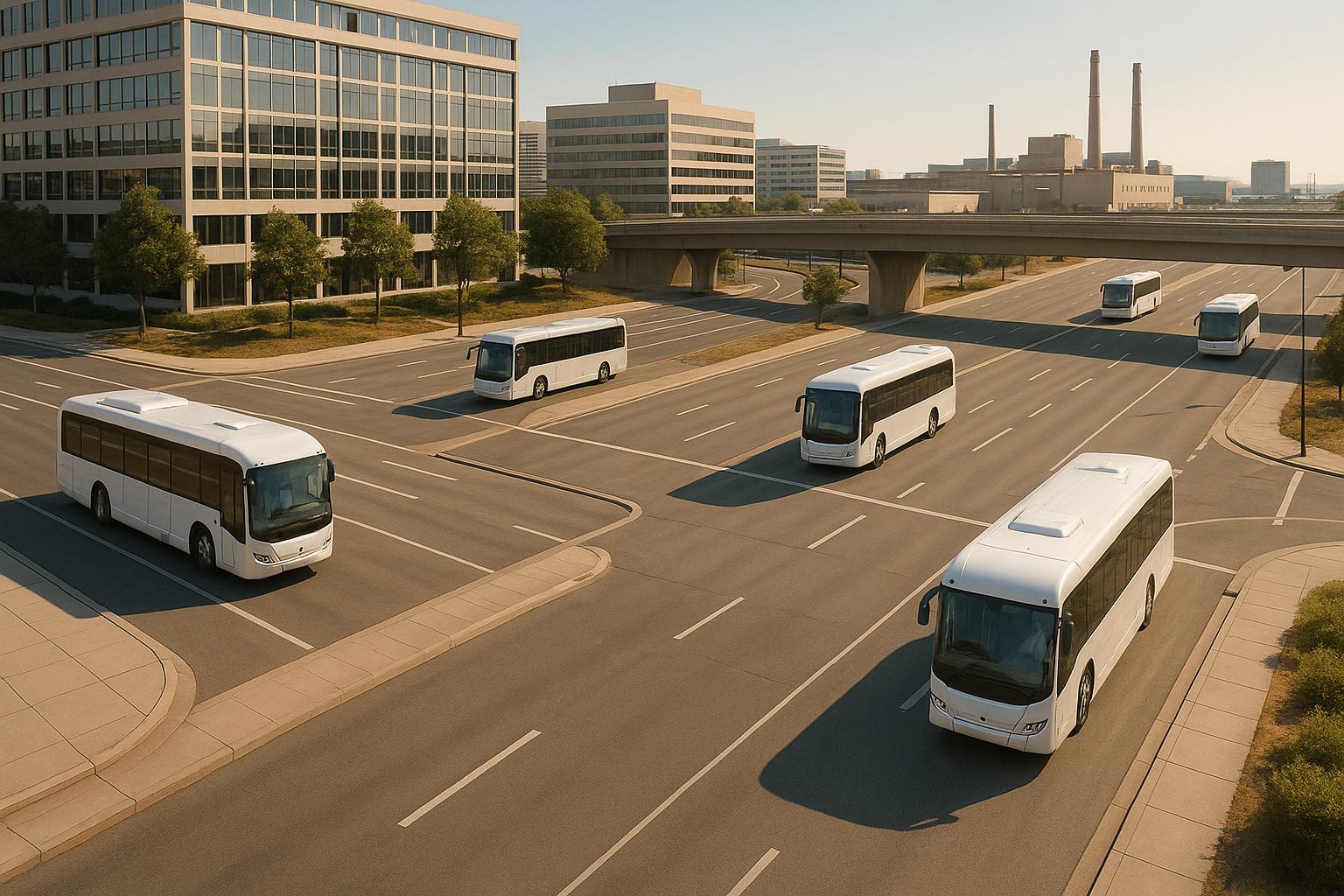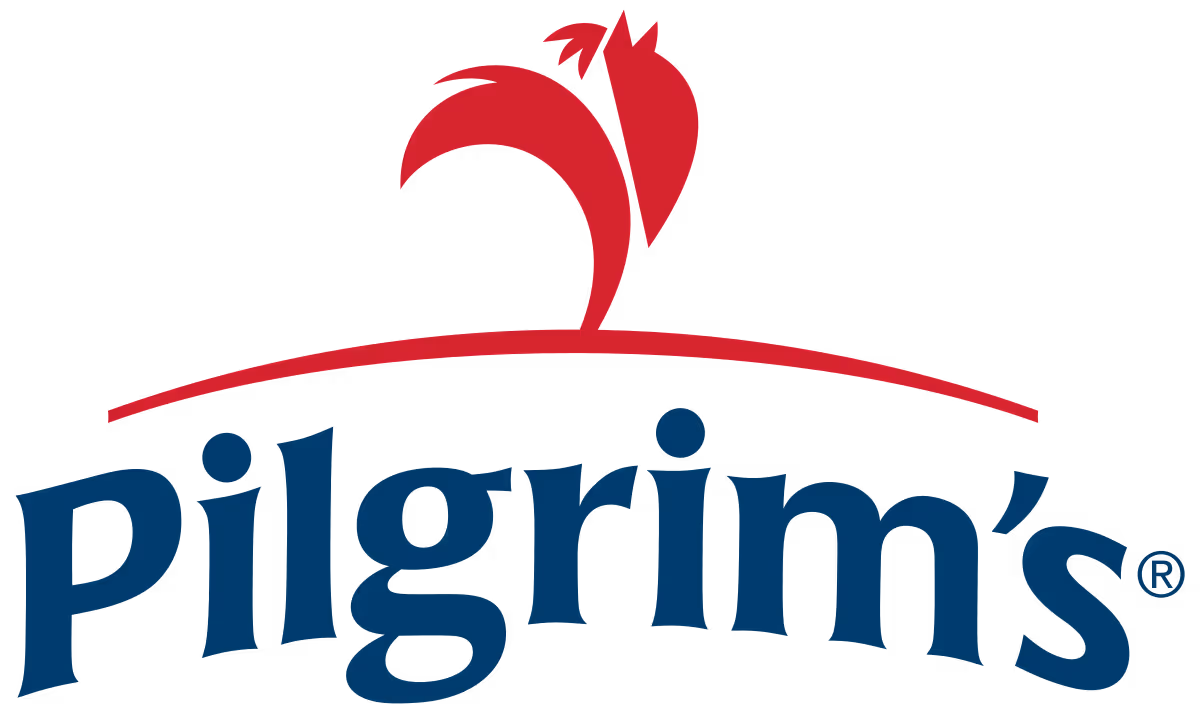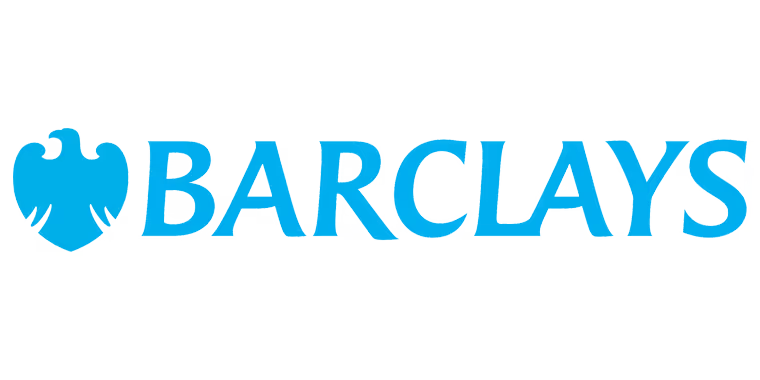Case Study: Scaling Shuttles for Large Workforces

Introduction
Companies with growing workforces face a major challenge: transportation. Without reliable commuting options, businesses risk recruitment struggles, higher turnover, and operational delays. Scalable shuttle programs are a smart solution, offering reliable access to worksites, improving employee satisfaction, and cutting costs.
Key takeaways from Tesco's case:
- Problem: Limited public transit and parking issues hindered recruitment and retention.
- Solution: Partnering with Zeelo to launch a shuttle program tailored to shift schedules and employee locations.
- Results: 150% increase in ridership, 30% higher retention, and reduced commute times by 50%.
This case highlights how shuttle services can directly impact workforce accessibility, retention, and operational efficiency.
Background: The Company and Their Problems
Tesco's Distribution Centre offers a clear example of how rapid business growth can strain transportation systems and disrupt operations. Over a span of two years, the company faced significant challenges in growing its workforce beyond 600 employees. The root of the problem? Transportation barriers that made it difficult for potential employees to reliably access the facility. These issues highlighted the need for a scalable transportation solution that could grow alongside their expanding business.
The inability to meet headcount targets directly impacted store operations. As the Distribution Centre Manager explained:
"If I go back two years, we only had 600 colleagues, but struggled to hit required headcount."
This wasn’t because of a lack of available workers in the labor market. Instead, the issue was the difficulty potential employees faced in commuting to the facility for their shifts, making transportation a critical bottleneck.
Location and Operational Challenges
The distribution center’s location presented unique challenges. Situated in an industrial zone with limited public transit options, the site was hard to access - especially during late-night and early-morning shifts when public transportation was either unavailable or unreliable. Insufficient parking further compounded the problem. With more employees driving to work, congestion became a frequent issue, affecting punctuality and overall efficiency. By contrast, professional shuttle services have demonstrated up to 98% on-time performance, emphasizing how individual commuting arrangements often fall short.
Adding to the complexity, the facility operates 24/7 with a variety of shift schedules. Employees needed transportation solutions that could accommodate these varying start times while addressing safety concerns, particularly during off-peak hours when commuting options were limited.
Why They Needed Scalable Shuttle Solutions
Given these challenges, a flexible shuttle system became a necessity. Traditional public transit options restricted hiring to individuals living nearby or those with reliable personal vehicles, which limited the company’s ability to expand its workforce. Transportation issues also contributed to higher employee turnover, as unreliable commutes pushed workers to seek employment elsewhere.
A scalable shuttle solution was critical for addressing these mobility challenges. Such a system would allow the company to adapt to fluctuating workforce needs - whether driven by seasonal demand, varying shift patterns, or future growth plans. Beyond improving accessibility, the shuttle program also aimed to reduce hidden costs tied to absenteeism, employee turnover, and recruitment struggles. By investing in a flexible transportation strategy, Tesco could better support its workforce and ensure smoother operations.
Building and Launching a Scalable Shuttle Program
Faced with significant transportation challenges, Tesco teamed up with Zeelo to create a flexible shuttle program. The initiative focused on understanding employee commuting habits, leveraging technology for seamless management, and ensuring the system could adapt to workforce changes. These efforts tackled the transportation barriers head-on, providing a strong foundation for a scalable solution.
Analyzing Employee Transportation Needs
The first step to success was understanding where employees lived and how they commuted. Zeelo began with a 15-minute consultation to assess Tesco's unique needs and share insights from similar projects.
By working closely with Tesco’s HR team, Zeelo analyzed anonymized employee address data to locate residential clusters and identify commuting trends. This data was crucial in pinpointing areas where reliable transportation was most needed, particularly in places with limited public transit options.
Surveys were also conducted to gather employees' commuting preferences and current travel methods. Additionally, operational factors like shift schedules, peak hiring periods, and seasonal workforce demands were evaluated. A review of public transit availability throughout the day helped identify gaps where shuttle services could make the biggest impact.
Using Technology for Better Management
Technology was at the heart of the shuttle program’s success. Zeelo’s in-house routing tools processed the anonymized address data to design routes that matched employee clusters and operational needs. This ensured optimal pickup locations and service times, maximizing participation.
Employees benefited from a dedicated rider app, which allowed them to book rides, reserve seats, track shuttles in real time, receive updates, and purchase travel passes. This streamlined the process and minimized administrative tasks. On the management side, Tesco had access to a client portal that provided real-time updates and full visibility across multiple locations. This allowed the team to monitor ridership trends and make data-driven decisions about route adjustments and fleet size.
Real-time tracking ensured both employees and administrators could monitor shuttle operations, helping achieve a 98% on-time performance rate. Additionally, detailed analytics provided usage reports, giving Tesco insights into demand patterns and helping refine the program.
Building Flexibility into Program Design
To address Tesco’s evolving transportation needs, the program was built with adaptability in mind. Routes included multiple pickup locations and varied service times to cater to different employee schedules and residential areas, ensuring the system could evolve alongside workforce changes.
The program offered a range of vehicle options, from smaller transit vans to larger coaches. This approach avoided unnecessary upfront investments while allowing capacity to scale up as ridership grew.
Service times were tailored to accommodate off-peak hours and diverse shift patterns. Flexible contracts with transportation providers enabled Tesco to quickly adjust capacity, add routes, or expand service areas without lengthy renegotiations.
Cost-sharing mechanisms were integrated into the booking app, reducing administrative complexity while promoting financial sustainability. The program also included adaptable safety and compliance measures, such as vehicle maintenance protocols, driver training, and passenger safety guidelines. These measures ensured the program could respond swiftly to changing circumstances, like those brought on by the COVID-19 pandemic.
Results and Outcomes
The scaled shuttle program brought significant gains in both operational efficiency and employee satisfaction. The results clearly show how this initiative positively impacted Tesco's business operations and workforce management.
Measured Success Data
Thanks to the program's thoughtful design, tangible improvements quickly followed. Weekly ridership soared from 400 to 1,000 bookings in just one year - a 150% jump that highlighted strong employee engagement. Zeelo's technology platform achieved an impressive 97% on-time performance across all routes, while the rider app earned a high rating of 4.7 out of 5.
Optimized routes also cut average commute times in half, reducing them from over 60 minutes to just 30 minutes. This gave employees more personal time between shifts and allowed them to plan their schedules with greater ease.
The program also delivered environmental benefits. By reducing individual car use, it eased parking congestion around Tesco's facilities and lowered overall carbon emissions tied to employee commutes.
Employee and Management Feedback
The response from employees was overwhelmingly positive. A striking 92% of employees reported that the shuttle service played a key role in their decision to accept a job, underlining its importance in recruitment efforts. Additionally, the program supported a 30% increase in 90-day retention rates, with employees citing better work-life balance and reduced commuting stress as major perks.
"The team ensured a smooth, cost-efficient, and optimized service for our business." – Procurement Manager
Management also praised the program for its operational and administrative benefits. The client portal offered real-time insights into program performance, while automated booking and payment systems significantly reduced manual workload. Supervisors observed improved punctuality and fewer absenteeism issues among employees who used the shuttle service. These benefits are clearly reflected in the comparative metrics below.
Before and After Comparison Chart
The table below highlights the transformation achieved through the scaled shuttle program:
These results make it clear that the scaled shuttle program delivered benefits across multiple business areas. By improving employee satisfaction, streamlining operations, and cutting costs, the program created a sustainable transportation solution that supported Tesco's growth and workforce needs.
Beyond addressing immediate transportation challenges, the program also advanced broader business goals like talent acquisition, employee retention, and reducing environmental impact. The measurable improvements in these areas confirmed the value of investing in scalable shuttle infrastructure and set the stage for future growth.
Key Takeaways and Best Practices
The success of the shuttle program offers valuable insights and practical strategies for scaling transportation solutions. Growing weekly ridership from 400 to 1,000 highlights how thoughtful planning and execution can drive measurable results across various business objectives.
What Made This Program Successful
The program's success was rooted in a combination of data analysis, technology, adaptability, and collaboration. Here's how these elements worked together:
- Data-Driven Decisions: Using anonymized employee address data, the team identified gaps in public transportation and optimized shuttle routes to fill those needs. This targeted approach ensured the service met real demand effectively.
- Integrated Technology: Rider apps and client portals played a key role in real-time route optimization and service reliability. These tools provided the foundation for smooth operations and informed decision-making.
- Flexible Routing and Scaling: The program’s ability to adapt to shifting employee needs through dynamic route adjustments and scalable vehicle options ensured it stayed aligned with workforce demands.
- Collaboration with Stakeholders: Close coordination with stakeholders allowed the program to evolve alongside changing staffing requirements, ensuring it remained relevant and effective.
Tips for Scaling Shuttle Programs
For organizations looking to scale their shuttle operations, these lessons provide a roadmap to success:
- Start with a Needs Analysis: A thorough assessment is essential before expanding operations. For example, Jaguar Land Rover initially struggled with low ridership. By analyzing address data and seeking expert input, they targeted new cities and achieved a 150% increase in ridership[2]. This highlights the importance of groundwork in avoiding costly mistakes.
- Leverage Technology Early: Introducing rider apps, management portals, and route optimization tools from the beginning simplifies scaling. Retrofitting these technologies later can lead to unnecessary challenges and inefficiencies[2].
- Partner with Experienced Providers: Collaborating with established transportation operators can streamline deployment and ensure consistent service. Zeelo’s network of over 200 vetted partners nationwide allows businesses to focus on their core goals while experts handle logistics[1].
- Design for Flexibility: Programs need to accommodate evolving demands. Amazon’s shuttle service, for instance, launched within 24 hours, offering 4 pickup locations and 6 daily travel times while maintaining a 98% on-time performance rate[3]. This adaptability ensures the service can adjust to changing schedules and operational needs.
- Track Key Metrics: Go beyond counting riders. Monitor metrics like recruitment success, retention rates, employee satisfaction, and efficiency. One example is Wonolo’s client, who improved their job fill rate from 62% to 104% after implementing a shuttle service, showcasing how transportation can directly impact business outcomes[2].
- Plan for Multi-Site Expansion: Treat each location individually while maintaining program consistency. Organizations managing over 2.5 million rides annually for 120+ clients have shown that centralized technology platforms allow for effective oversight while enabling local customization[2]. This approach reduces risks and builds expertise for future growth.
Ultimately, shuttle services aren't just about moving people - they’re powerful tools for driving recruitment, retention, productivity, and efficiency. When aligned with business goals, they can become a strategic asset for workforce management and long-term growth.
Conclusion: The Business Value of Scalable Shuttle Programs
The case study above highlights how scalable shuttle programs can play a pivotal role in addressing workforce, financial, and environmental challenges. These programs aren’t just transportation solutions - they’re strategic investments that deliver measurable results.
The financial impact is hard to ignore. For example, Fidelity International saved $519,000 (a 29% reduction) on a 22-year contract by leveraging data-driven route optimization. Similarly, a grocery client saw over $480,000 in returns by converting temporary workers into permanent staff, thanks to improved transportation access.
Better transportation also translates into workforce benefits. One logistics company reported a 30% improvement in 90-day employee retention after just 10 months of implementing shuttle services. This directly reduced recruitment and training costs while ensuring smoother operations.
Operational efficiency is another standout advantage. Zeelo, for instance, manages over 50,000 rides annually for clients like St John’s College, significantly reducing administrative workloads. Their technology-driven approach not only enhances efficiency but also increases shuttle usage by 50% through smart, data-backed route design - all while maintaining excellent on-time service.
Environmental impact is yet another key advantage. By cutting down on individual car usage and promoting carbon-neutral transportation, scalable shuttles help businesses meet sustainability goals, reduce parking infrastructure costs, and ease urban traffic congestion.
For growing organizations, scalability is indispensable. Shuttle routes can start small and expand to serve thousands of passengers across multiple locations. Zeelo’s network, for example, supports over 120 clients and facilitates more than 2.5 million rides annually, proving that transportation solutions can grow alongside business demands.
As shown in the case study, well-designed, tech-enabled shuttle programs deliver clear benefits - better recruitment, higher retention, improved operational efficiency, and cost savings. Choosing scalable platforms that adapt to workforce needs while maintaining top-notch service is the key to unlocking these advantages.
These findings reinforce why scalable and technology-driven shuttle solutions are essential for businesses navigating today’s evolving demands.
We help companies and schools achieve their transportation program goals
Corporate shuttles


Warehouse/Distribution


Schools & Universities


Become a partner


Want to know how we can help you?













